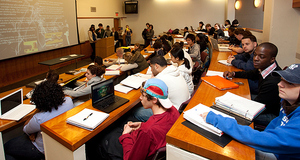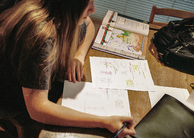Incorporating Technology into the Modern English Language Arts Classroom
By
2011, Vol. 3 No. 01 | pg. 2/2 | « The assignment requires a video or audio recording of the interview and a printed transcript, which is later edited into a narrative to accompany the oral history. Upon completion, the project is published online for classmates and community to see (p. 37). A project such as this one addresses the ELA standards of reading, writing, listening, and speaking, and does so while simultaneously incorporating technology and modern genres of expression, all while fostering a sense of community through student involvement. The digital tools at work here expand the boundaries of expression and create potential for students to reach a larger audience with their public work. A review of literature by Whitin (2009) echoes the importance of using digital tools and genres to express understandings and knowledge, and to reach a greater audience with student work. The implementation strategies discussed are designed to develop human potentials for reading, understanding, and composing digital texts, with the idea behind this approach being to place greater value on modes (musical, visual, dramatic) that have traditionally been valued for their aesthetics. Placing academic value on those modes introduces new methods for teachers to reach lower-achieving students, and to expand understandings attained by students in general, through the introduction of digital tools as a means to "facilitate literary conversations" (p. 408).Whitin's project was introduced to a group of graduate-level, pre-service teachers, and centered on Ruby Bridges's autobiographical work Through my Eyes. The book itself is a multi-genre piece, using various forms of language and expression, including interviews, news articles, and photographs. In phase one of this project, students read the work, gaining exposure to, and understanding of, the multiple modalities of expression used by the author. Elements of phase one included direct instruction about the use of visual design elements and reflection through an online journal. The students were able to "[develop] proficiency in using these modalities to interpret literature," integrating traditional and modern strategies for literature comprehension (p. 409). After having an opportunity to explore the text, the students moved on to phase two of the project, in which they responded to the text via a number of multi-modal activities. Through the use of online response prompts, collages, and literature circle discussions and activities, students interacted with one another to determine ways in which the various modes of expression could be used to understand and interpret meaning drawn from the book. Finally, in phase three, groups of students composed digital movies that presented their interpretations of the text, as well as the previous "representational resources: visual, dramatic, oral, aural, and written responses," which they had used to explore and interpret the text during phase two (p. 410). Whitin's students may have used the various modes of response in different ways, but they all succeeded in interpreting and understanding the work, and interacting with one another in discussion of it. The use of digital films is one application of technology in the classroom for the purpose of assessment, and it might focus on the interpretation of a text, or turn inward on the student, resulting in a much more personal storytelling experience. Digital storytelling, as described by Gregory, Steelman, and Caverly (2009), "is a short (i.e., 3-5 minute) movie centered on the recorded writing of students" (p. 42). These pieces could be personal narratives, telling the story of a personal experience, using public images and music to convey a visual and audio message for their narrative. Mini-stories encourage students to make connections between texts and the real world, by selecting public imagery and sounds to reinforce their recorded reading of an important excerpt of the text. Finally, students might compose an essay about current events, and then create a digital argument, or persuasive digital story, supplementing their arguments with public images and music. This type of activity serves to assist in the development of skill in composing various styles of writing, and offers avenues for community engagement. Another approach to storytelling, which does not require technology, is the composition of screenplays. Bedard and Fuhrken (2010) take the focus off of the technology, and place it back on the academic and creative processes involved in storytelling. The screenplay introduces a new genre for students to explore, putting a modern twist on traditional creative writing. The project begins with immersion of the students in the genre, with direct instruction on the components of this new type of writing, and by reading existing screenplays from successful, well-known films. In addition to the typical literary devices used by authors, students must now become familiar with screen direction, lighting, angles, as well as the lingo and format of the genre. Throughout this process, students gradually transition into thinking of their own original work (p. 48). After becoming familiar with the genre and examples of successful work, students begin the process of generating ideas and planning their stories. In a workshop-style classroom setting, students begin outlining plot and characters, formulating a beginning, middle, and end of the story, and utilizing industry techniques such as storyboarding to illustrate the flow of their story. The workshop environment in the classroom for this project is necessary to promote collaboration and critical input from peers, as students proceed with the writing and editing of their works. In the end, each student composes a very creative and personal story, to which they should feel a strong connection (pp. 49-50). While this activity might not directly incorporate technology, students must undertake it with the technology of filmmaking in mind (p. 50). Perhaps this type of project could work in conjunction with an elective course in film or photography, where some of the outstanding screenplays might actually be produced. Even without the actual production of the films, students are engaged with a fresh, modern genre, and gain a true appreciation for the craft of writing for the screen; students learn to discover what matters most to them, and then find a creative way express it. Expression is important in the English classroom. Understanding of texts, authors, and us as teachers and students, is fundamental to literacy, both traditional and modern. In the end, technology provides us with new ways to communicate our ideas and express our knowledge, feelings, and stories. Within the confines of the New York State standards for English, "incorporating technology often allows [us] to include additional standards into a lesson that may have addressed only one or two without the technologies. (For example, [technology] usually incorporates reading, writing, listening, and speaking for social interaction)" (Mr. C., personal communication, November 10, 2010). While some may remain resistant to the change that washes over classroom instruction as a result of technological and societal advancement, it is important for us to be progressive in the implementation of new forms of media and literacy in our classrooms. The digital natives we find before us in class today will be operating the businesses, running the governments, and teaching the students of tomorrow. A remixing of traditional and modern methods and literacies will best equip them for the challenges they will face by instilling in them a respect for the literary heritage of the English language, and the tools necessary to be successful in this, and the information age to come. ReferencesAlvermann, D. (2007). Multiliterate youth in the time of scientific reading instruction. In K. Beers, R.E. Probst, & L. Reif (Eds.), Adolescent literacy: Turning promise into practice (pp. 19-26). Portsmouth: Heinemann. Aronson, D. (2010). Pulling back the curtain on teaching literature: Author seeks to show high school literature teachers that they are already teachers of reading. The Council Chronicle, 20(2), 6-8. Bedard, C., & Fuhrken, C. (2010). Everybody wants somebody to hear their story: High school students writing screenplays. English Journal, 100(1), 47-52. Davis, C., & Davis, J. (2005). Using technology to create a sense of community. English Journal, 94(6), 36-41. Gainer, J.S. & Lapp, D. (2010). Remixing old and new literacies = motivated students. English Journal, 100.1, 58-64. Gregory, K., Steelman, J., & Caverly, D.C. (2009). Techtalk: Digital storytelling and developmental education. Journal of Developmental Education, 33(2), 42-43. Tarasiuk, T. J. (2010). Combining traditional and contemporary texts: Moving my English class to the computer lab. Journal of Adolescent & Adult Literacy, 53(7), 543-52. Whitin, P.E. (2009). "Tech-to-stretch": Expanding possibilities for literature response. The Reading Teacher, 62, 408-418. Suggested Reading from Inquiries Journal
Inquiries Journal provides undergraduate and graduate students around the world a platform for the wide dissemination of academic work over a range of core disciplines. Representing the work of students from hundreds of institutions around the globe, Inquiries Journal's large database of academic articles is completely free. Learn more | Blog | Submit Latest in Education |


















